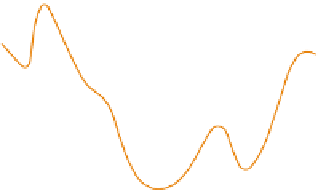Geoscience Reference
In-Depth Information
decrease after midday is slowed by heat supplied
from the ground. Minimum air temperature
occurs shortly after sunrise due to the lag in
the transfer of heat from the surface to the air.
The annual pattern of the net radiation budget
and temperature regime is closely analogous to
the diurnal pattern, with a seasonal lag in the
temperature curve relative to the radiation cycle,
as noted above (p. 59).
There are marked latitudinal variations in the
diurnal and annual ranges of temperature.
Broadly, the annual range is a maximum in higher
latitudes, with extreme values about 65
(A)
Absorbed solar
radiation
surplus
Net infrared
radiation
deficit
0
00
06
12
18
24
Hours
(B)
Air
temperature
N related
to the effects of continentality and distance to the
ocean in interior Asia and North America (
Figure
3.24
). In contrast, in low latitudes the annual
range differs little between land and sea owing to
the thermal similarity between tropical rainforests
and tropical oceans. The diurnal range is a
maximum over tropical land areas, but it is in the
equatorial zone that the diurnal variation of
heating and cooling exceeds the annual variation
(
Figure 3.23C
), due to the small seasonal change
in solar elevation angle at the equator.
°
Net
radiation
surplus
0
deficit
00
06
12
Hours
18
24
80
(
C)
A
D
Annual
Diurnal
C
M
3 mid-continental areas
maritime areas
(30°W, 80°E and 170°W)
40
70
?
60
AC
30
50
40
AM
20
30
DC
20
?
10
?
10
?
DM
?
0
0
E ATMOSPHERIC ENERGY
AND HORIZONTAL HEAT
TRANSPORT
Thus far, we have given an account of the earth's
heat budget and its components. We have already
referred to two forms of energy: internal (or heat)
energy, due to the motion of individual air
molecules, and latent energy, which is released by
condensation of water vapor. Two other forms of
energy are important: geopotential energy due to
gravity and height above the surface, and kinetic
energy associated with air motion.
Geopotential and internal energy are interre-
lated, since the addition of heat to an air column
not only increases its internal energy but also
adds to its geopotential as a result of the vertical
expansion of the air column. In a column
extending to the top of the atmosphere, the
geopotential is approximately 40 percent of the
90°N
60°
30°
0°
Latitude
30°
60°
90°S
Figure 3.23
Curves showing diurnal variations
of radiant energy and temperature. A Diurnal
variations in absorbed solar radiation and infrared
radiation in the middle and low latitudes. B Diurnal
variations in net radiation and air temperature in the
middle and low latitudes. C Annual (A) and diurnal
(D) temperature ranges as a function of latitude and
of continental (C) or maritime (M) location.
Source: From Paffen (1967). Courtesy of Erdkunde.
sunrise and an hour or so before sunset, with a
midday maximum. The delay in the occurrence of
the maximum air temperature until about 14:00
hours local time (
Figure 3.23B
) is caused by the
gradual heating of the air by convective transfer
from the ground. Minimum
R
n
occurs in the early
evening, when the ground is still warm; there is
a slight increase thereafter. The temperature







































































